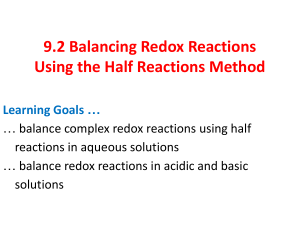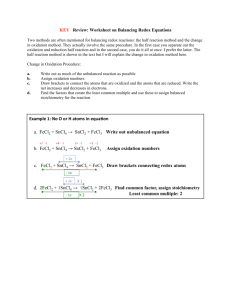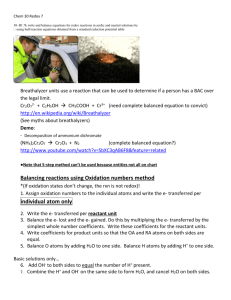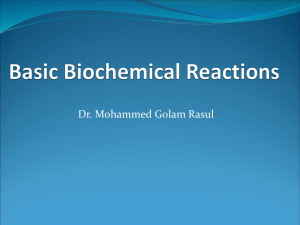4.9 Balancing Redox Reactions: The Half
advertisement
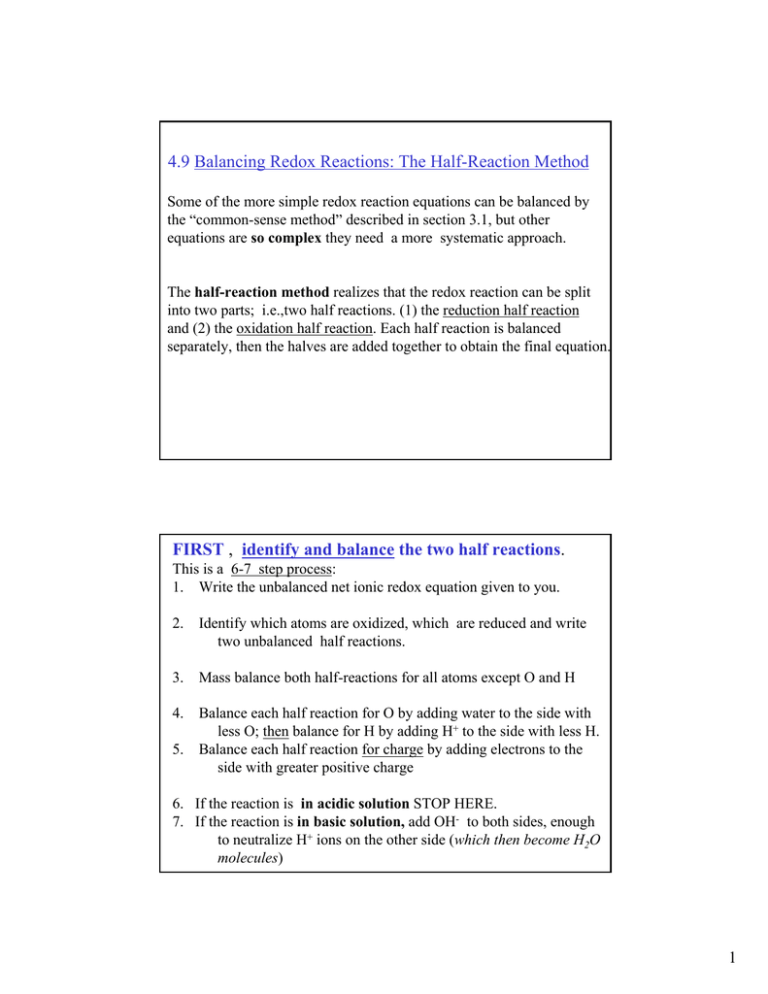
4.9 Balancing Redox Reactions: The Half-Reaction Method Some of the more simple redox reaction equations can be balanced by the common-sense method described in section 3.1, but other equations are so complex they need a more systematic approach. The half-reaction method realizes that the redox reaction can be split into two parts; i.e.,two half reactions. (1) the reduction half reaction and (2) the oxidation half reaction. Each half reaction is balanced separately, then the halves are added together to obtain the final equation. FIRST , identify and balance the two half reactions. This is a 6-7 step process: 1. Write the unbalanced net ionic redox equation given to you. 2. Identify which atoms are oxidized, which are reduced and write two unbalanced half reactions. 3. Mass balance both half-reactions for all atoms except O and H 4. Balance each half reaction for O by adding water to the side with less O; then balance for H by adding H+ to the side with less H. 5. Balance each half reaction for charge by adding electrons to the side with greater positive charge 6. If the reaction is in acidic solution STOP HERE. 7. If the reaction is in basic solution, add OH- to both sides, enough to neutralize H+ ions on the other side (which then become H2O molecules) 1 EXAMPLE: Write down the two balanced half reactions for the following unbalanced net ionic redox equations: (a) Cr2O72- (aq) + Cl- (aq) Cr3+ (aq) + Cl2 (aq) (in acidic solution) (b) ClO (aq) + Cr(OH)4 (aq) CrO42- (aq) + Cl- (aq) (in basic solution) SOLUTION: (a) 1. Two half reactions unbalanced are: Oxidation: Cl- (aq) Cl2 (aq) Reduction : Cr2O72- (aq) Cr3+ (aq) [ Cl oxidized from -1 to 0 ] [ Cr reduced from +6 to +3 ] 2. Mass balance atoms except O and H. Oxidation: 2 Cl- (aq) Cl2 (aq) Reduction: Cr2O72- (aq) 2 Cr3+ (aq) 3. Now mass balance O and H. Oxidation: 2 Cl- (aq) Cl2 (aq) [ No change] Reduction: Cr2O72- (aq) + 14 H+ (aq) 2 Cr3+ (aq) + 7 H2O (l) 4. Balance each half reaction for charge by adding electrons to side most positive Oxidation: 2 Cl- (aq) Cl2 (aq) + 2eReduction: Cr2O72- (aq) + 14 H+ (aq) + 6 e2 Cr3+ (aq) + 7 H2O (l) 5. Stop you have the two balanced half reactions (in acidic solution) (b) ClO- (aq) + Cr(OH)4- (aq) 2. CrO42- (aq) + Cl- (aq) (in basic solution) Two half reactions are: Oxidation: Cr(OH)4- (aq) CrO42- (aq) Reduction: ClO (aq) Cl (aq) [ Cr oxidized from +3 to +6] [ Cl reduced from +1 to -1 ] 3. Mass balance atoms except for O and H Already mass balanced 4. Now mass balance for O and H Oxidation: Cr(OH)4- (aq) CrO42- (aq) + 4 H+ (aq) + Reduction: ClO (aq) + 2 H (aq) Cl- (aq) + H2O (aq) 5. Balance each half reaction for charge using eOxidation: Cr(OH)4- (aq) CrO42- (aq) + 4 H+ (aq) + 3 e+ Reduction: ClO (aq) + 2 H (aq) + 2 eCl- (aq) + H2O (aq) 2 6. Reaction in basic solution: Therefore add same # of OHions to both sides to neutralize H+ ions. Oxidation: Cr(OH)4- (aq) + 4 OH- (aq) Cr(OH)4- (aq) + 4 OH- (aq) CrO42- (aq) + 4 H+ (aq) + 4 OH- (aq) + 3 eCrO42- (aq) + 4 H2O (l) + 3 e- Reduction: ClO- (aq) + 2 H+ (aq) + 2 OH- (aq) + 2 eClO- (aq) + 2 H2O (l) + 2 eClO- (aq) + H2O (l) + 2 e- Cl- (aq) + H2O (aq) + 2 OH- (aq) Cl- (aq) + H2O (l) + 2 OH- (aq) Cl- (aq) + 2 OH- (aq) PROBLEM Balance the following half reactions; (a) (acidic) VO2+ (aq) V3+ (aq) (b) (basic) Ni(OH)2 (s) Ni2O3 (s) Answers: (a) VO2+ (aq) + 2 H+ (aq) + e- V3+ (aq) + H2O (l) (b) 2 Ni(OH)2 (s) + 2 OH- (aq) Ni2O3 (s) + 3 H2O (l) + 2 e- (oxidation) (reduction) 3 This document was created with Win2PDF available at http://www.daneprairie.com. The unregistered version of Win2PDF is for evaluation or non-commercial use only.
